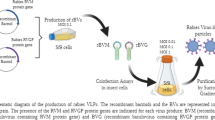Summary
The Pasteur strain of fixed rabies virus was adapted to primary cell cultures of Japanese quail embryos and designated as MNIIVP-74. In the course of adaptation the virus pathogenicity for rabbits by the intracerebral route decreased considerably and the pathogenicity for rabbits and adult white mice by extraneural routes was completely lost. After inoculation of Japanese quail embryo cell cultures, a titer of the virus in the culture fluid at 4 days was 6.25–7.0 lg LD50/ml (by the intracerebral inoculation of adult white mice). Viral antigen could be detected by immunofluorescence in the cytoplasm of approximately 60 per cent of the cells. Virus multiplication was accompanied by intensive interferon production. In cultures of BHK-21/13S cells the titer of the virus reached was 5.75 lg LD50/ml at 24 hours and about 30 per cent of the cells were affected. The MNIIVP-74 virus showed a high immunogenic activity in rabbits, guinea pigs and mice.
Similar content being viewed by others
References
Abelseth, M. K.: Propagation of rabies in pig kidney cell culture. Canad. vet. J.5, 279 (1964).
Atanasiu, P., Tsiang, H., Gamet, A.: Nouveau vaccin antirabique humain de culture cellulaire primaire. Collect. Ann. Inst. Pasteur125, 419–432 (1974).
Atanasiu, P., Laurent, C.: Multiplication du virus de la rage des rues sur une cellule gliale (ependimome de la sauris) en culture de tissus; aspect histologique. C.R. Acad. Sci. (Paris)245, 2562–2564 (1957).
Fernandes, M. V., Pomerat, C. M.: Cytopathogenic effect of rabies virus in nervous tissuein vitro. Zschr. Zellforsch.53, 431–437 (1961).
Kissling, R. E.: Growth of rabies virus in non-nervous tissue culture. Proc. soc. expt. Biol. Med.98, 223–225 (1958).
Kondo, A., Takashima, J., Suzuki, M.: Inactivated rabies vaccine of chick embryo cell culture origin. In: Int. Symposium of Rabies (II), Lyon, 1972. (Symp. series immunobiol. standard),93, 353–366. Basel: Karger 1974.
Vernon, S. K., Neurath, A. R., Rubin, B. A.: Electron microscopic studies on the structure of rabies virus. J. Ultrastructure Res.41, 29–42 (1972).
Webster, L. F., Clow, A. D.: Propagation of rabies virus in tissue culture and the successful use of culture virus as an antirabic vaccine. Science84, 487–488 (1936).
Webster, L. F., Clow, A. D.: Propagation of rabies virus in tissue culture. J. exp. Med.66, 125–131 (1937).
Wictor, F. J., Fernandes, M. V., Koprowski, H.: Cultivation of rabies virus in human diploid cell strain WI-38. J. Immunol.93, 353–366 (1964).
Author information
Authors and Affiliations
Additional information
With 3 Figures
Rights and permissions
About this article
Cite this article
Bektemirova, M.S., Osidze, D.F., Pille, E.R. et al. Properties of rabies virus (MNIIVP-74 strain) adapted to Japanese quail embryo cell culture. Archives of Virology 61, 61–68 (1979). https://doi.org/10.1007/BF01320592
Received:
Accepted:
Issue Date:
DOI: https://doi.org/10.1007/BF01320592




